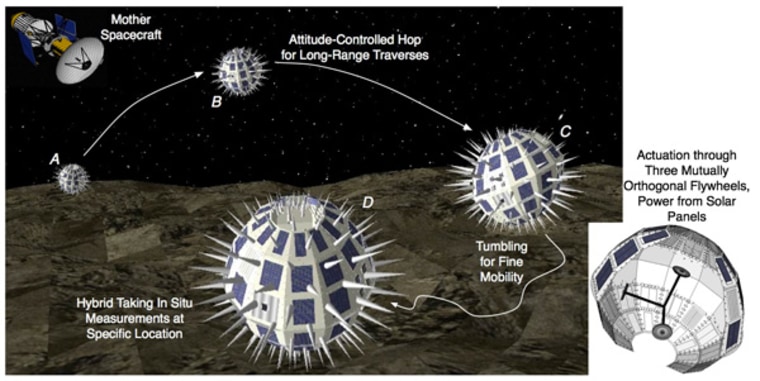
A spike-covered robotic hedgehog is being developed to precisely hop, bounce and tumble across the Martian moon Phobos on a scouting trip for a human mission to Mars, according to a space scientist working on the project.
The Martian moon Phobos is one of the red planet’s two satellites, each just a few kilometers wide. Many scientists consider the moon a must-visit destination to learn more about Mars, the evolution of the solar system, and, perhaps, use as a base camp for future robotic explorations of Mars.
First, though, scientists want to know more about the moon. They don’t even know, for example, whether it is an asteroid that was captured by Mars' gravity or a chunk of Mars that an asteroid impact flung into orbit.
If the moon is a chunk of Mars, studies of it could tell scientists more about the geology of the Red Planet without having to go all the way to Mars, which has extra costs associated with landing and taking off in its higher gravity.
The low-gravity of Phobos therefore makes it an attractive site of a future sample-return mission, according to Marco Pavone, an assistant professor in the Department of Aeronautics and Astronautics at Stanford University.
“But before we can bring things back, we need to know what we want to sample,” he told NBC News. “These robots are ideal because they provide you with enough small-scale surface information to pinpoint the area that is ideal for sampling.”
Pavone is developing the hedgehog in collaboration with NASA’s Jet Propulsion Laboratory and the Massachusetts Institute of Technology.
The 1.6-foot-wide, solar-powered robot is covered in spikes to help it navigate the micro-gravity environment of Phobos. Such low-gravity environments are difficult for wheeled robots since the wheels are prone to lose traction and spin uncontrollably.
“Instead of wheels, we have spikes to get traction,” Pavone said.
To get around, the hedgehog relies on three rotating discs inside it, each pointing in a different direction. The inertial forces of the spinning discs allows for nimble and precise maneuvering.
A quick acceleration of the discs, for example, allows it to hop. Spinning them faster results in a bound and slow spin allows for tumbles.
The robot will be controlled by a coffee-table-sized mothership called the Phobos Surveyor being designed and built at NASA’s Jet Propulsion Laboratory that will be in orbit around Phobos throughout the mission. It will carry up to six hedgehogs, releasing them one at a time.
“The idea would be to exploit the synergy between the Phobos Surveyor and the robots,” Pavone explained. “You do not want to land instruments for which the measurements can be carried out on the satellite.”
Large scale mapping and measurements will instead be made by the surveyor. Microscopes and other instruments will be used by the robots to make fine-scale measurements.
Given the long delay between the Martian system and Earth, the surveyor and hedgehog would do much of their work autonomously, Pavone noted.
While a hedgehog on the Martian moon is at a minimum 10 years distant, Pavone said he is confident a concept similar to this one, if not this one, will fly within the next 20 years.
“Small bodies [like Phobos] are currently central exploration targets for NASA,” he said. “So it is very likely that there are going to be a couple of missions to small bodies.”
In addition to Pavone, project members include Julie Castillo, Jared Lang, Christopher McQuin, Issa Nesnas and Nathan Strange at NASA’s Jet Propulsion Laboratory; Jeffrey Hoffman at the Massachusetts Institute of Technology, and Ross Allen at Stanford University.
John Roach is a contributing writer for NBC News Digital. To learn more about him, check out his website. For more of our Future of Technology series, watch the featured video below.